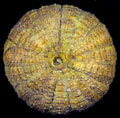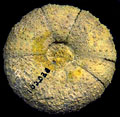The Echinoid Directory
Graphepleurus Clark, 1945, p. 315
[=Graphechinus Clark, 1945, p. 317 (lapsis calamis)]
| Diagnostic Features |
|
|---|---|
| Distribution | Miocene, Fiji. |
| Name gender | masculine |
| Type | Graphepleurus granularis Clark, 1945, p. 315, by original designation. |
| Species Included |
|
| Classification and/or Status |
|
| Remarks |
|



